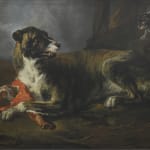Jan Baptist Weenix (1621-1659)
Jan Baptist Weenix was born in Amsterdam in 1621, the son of the architect Johannes Weenix and Grietgen Heeremans. His sister Lijsbeth married a painter, Barent Micker, whose brother Jan Micker was Weenix’s first teacher. His training with the Utrecht painter Abraham Bloemaert and his time in the Amsterdam studio of Claes Moeyaert were more formative. In 1639, Weenix married Josina de Hondecoeter, daughter of the landscape and animal painter Gijsbert de Hondecoeter. On October 30, 1642, Weenix drafted his will as he was planning to travel to Italy to experiment with art. In Rome, Weenix joined the Netherlandish artists society, the Bentvueghels. Around 1645 the artist probably entered the service of Cardinal Camillo Pamphili, the later Pope Innocent X, from whom he received at least one commission.
By June 1647, Weenix was back in Amsterdam. Two years later, he settled in Utrecht where together with Jan Both, he was elected an officer of the local painter’s guild. In 1657, Weenix moved to Huis ter Mey in Kennemerland, where he died in 1659. When the present painting was sold in the artist’s estate sale, it was sold as the second most expensive painting in the auction.[1]
Jan Baptist Weenix was a leader of the second generation of seventeenth century Dutch painters, painting views of Mediterranean seaports, landscapes, stil lifes with dead game, and some portraits, although these are quite rare. Weenix’s successor, Karen Kilimnik, has the same gamut of genres, not confining herself to one topic. Inspired by a range of sources, from old masters to pop culture, Kilimnik conjoins elements to construct her own narrative. Hound with a Joint of Meat, a Cat Looking on becomes dinner in the alley in Kilimnik’s universe. The gentle giant is one of the largest sized dog breeds originating from Germany. It descends from hunting dogs from the Middle Ages used for hunting wild boar and deer, and as guardians of German nobility. Fending off its catch from the cat in the seventeenth-century version, the cat and dog four centuries later may end up sharing a meal as the title suggests.
[1] Wagenberg, op.cit., p. 286, nf
Provenance
Possibly estate sale, Huis ter Mey, De Haar, 25 April 1659, lot 1
Anthony van Stamhorst, Amsterdam, estate inventory 19 February 1720
Sale Philipp Jacob Moureaux, Cologne, 12 October 1792, lot 26 [not in Lugt]
Sale, Auktionsverk Stockholm, Stockholm, 14 October 1984, lot 779
With P. & D. Colnaghi, Ltd., London
Private Collection, New York, until 1989
Their sale, Sotheby’s, New York, 12 January 1989, lot 108
Spencer A. Samuels & Company, New York, 1991-1993
Jack Kilgore & Co., New York
Exhibitions
Greenwich, Connecticut, Bruce Museum, Best in Show, The Dog in Art from the Renaissance to Today, 13 May - 27 August 2006;
Houston, The Museum of Fine Arts, 1 October 2006 - 1 January 2007
Literature
Burlington Magazine, volume 133, no. 1060, July 1991, p. xvi, advertisement Spencer A. Samuels
Edgar Peters Bowron, “An Artist’s Best Friend: Dogs in Renaissance and Baroque Painting and Sculpture,” in Best in Show, New Haven & London 2006, pp. 29-30 & 148, fig. 25
Anke A. Van Wagenberg-Ter Hoeven, Jan Baptist Weenix & Jan Weenix: The Paintings, Zwolle 2018, p. 286, no. 144, ill.



